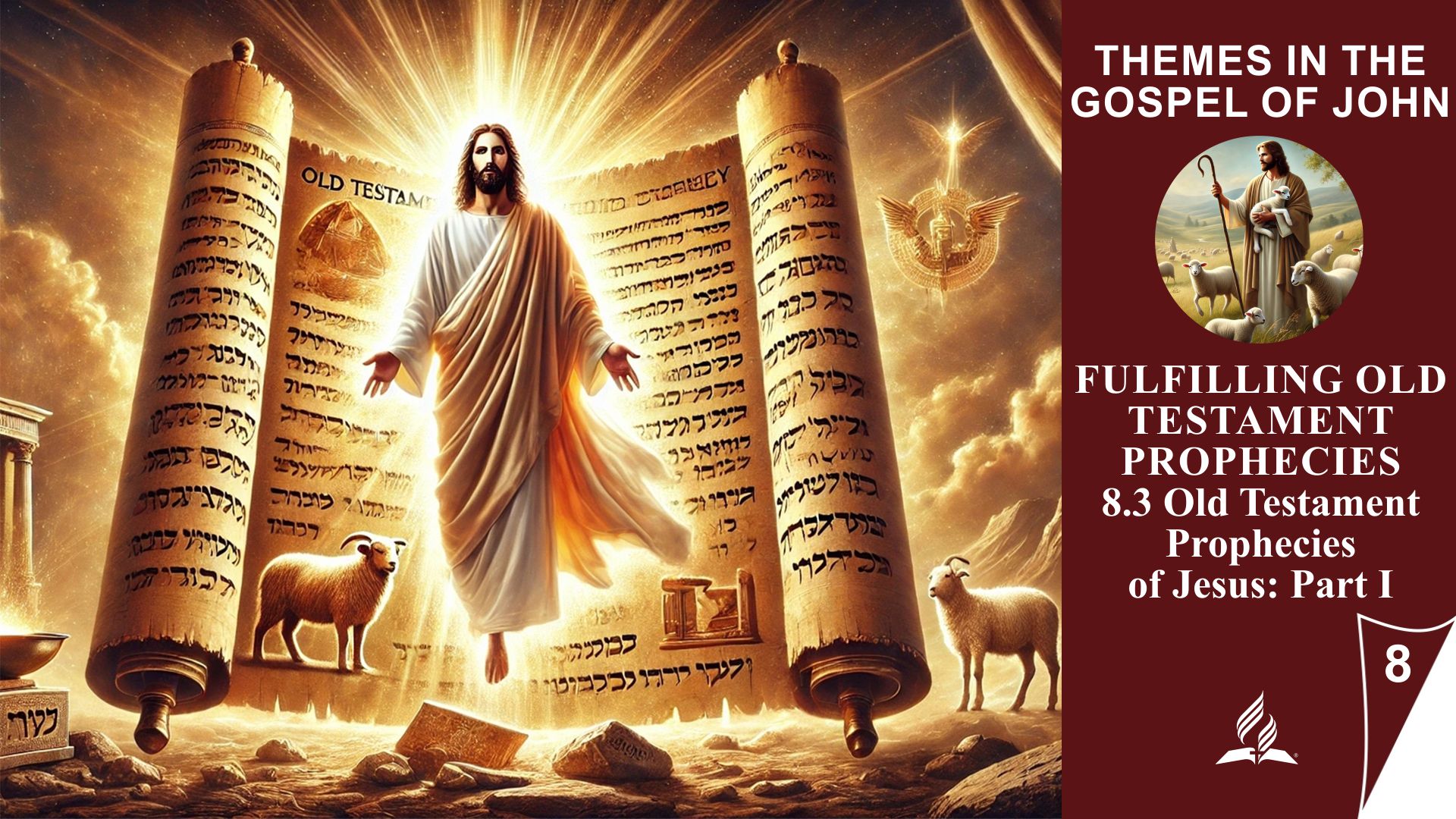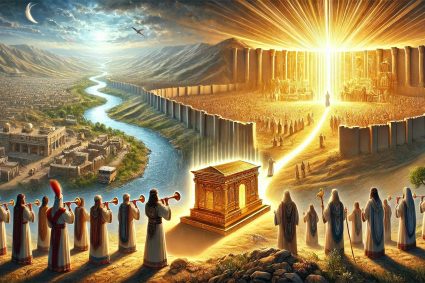


8.3 Old Testament Prophecies of Jesus: Part I
Fulfillment of Divine Promises
Jesus’ emphasis on the authority of the Holy Scriptures in His confrontations with the religious leaders shows us how deeply His identity and mission are rooted in the Old Testament. Jesus made it clear that Scripture is not just a text about God but a testimony about Himself—the Messiah who has come to fulfill the promises.
The religious leaders knew the Scriptures, but their hearts were hardened and closed to what Scripture revealed. Jesus used the authority of Scripture to show that His life, work, and mission were not coincidental but the fulfillment of a centuries-old divine plan.
The Significance of Scripture for Jesus
By using Scripture as evidence of His identity, Jesus taught that the Bible is a living and reliable source that reveals God’s plan. Through quotes and allusions to the Old Testament in the Gospels, especially in John, it becomes clear that Jesus does not stand outside of Scripture but is its central fulfillment.
Practical Lessons for Us Today:
-
Take Scripture Seriously: Like Jesus, we should view the Bible as a fundamental authority in our lives. It not only provides moral guidelines but also reveals God’s plan of redemption.
-
Seek Jesus in Scripture: Every promise, law, and prophecy ultimately points to Jesus. Studying the Old Testament should help us understand the depth and significance of His mission.
-
Keep Hearts Open: The religious leaders failed because, despite their knowledge, they were not willing to be convicted by the truth. We must examine ourselves to see if we are ready to recognize and accept God’s truth, even when it challenges us.
Conclusion
The Old Testament predictions about Jesus confirm the reliability of the Bible and God’s faithfulness to His promises. They invite us to recognize Jesus in the light of Scripture and to place our trust in the plan God had for our redemption from the beginning.
How Do the Following New Testament and Old Testament Passages Relate? In Other Words, How Does the New Testament Use These Texts to Testify About Jesus?
The mentioned Bible passages show how the New Testament uses the Old Testament to testify to the identity and mission of Jesus. They illustrate that Jesus does not stand outside of Scripture but is its central fulfillment. The New Testament authors interpret the Old Testament texts in light of Jesus’ life, death, and resurrection to reveal God’s plan of redemption.
-
John 1:23 and Isaiah 40:3
“I am the voice of one calling in the wilderness, ‘Make straight the way for the Lord!'” (John 1:23) directly refers to Isaiah 40:3, where a forerunner is announced to prepare the way for the Lord. John the Baptist is identified here as this forerunner who prepares the coming of Jesus, the Lord.
Significance:
-
Jesus is portrayed as the promised Lord for whom John the Baptist prepares the way.
-
This shows that Jesus is the fulfillment of the Old Testament promise of a Savior.
-
John 2:16–17 and Psalm 69:10
When Jesus drives the merchants out of the temple, the disciples quote Psalm 69:10: “Zeal for your house consumes me.” Here, Jesus’ passion for the purity of God’s house is connected with David’s prophetic lament.
Significance:
-
Jesus’ zeal for the temple fulfills the Psalm and points to His dedication to God’s honor.
-
The reference shows that Jesus reveals the deeper meaning of the temple, which finds its fulfillment in Him as the true “temple.”
-
John 7:38 and Jeremiah 2:13
In John 7:38, Jesus speaks of rivers of living water flowing from within believers, pointing to the Holy Spirit. Jeremiah 2:13 laments that the people of Israel have abandoned the “source of living water” (God).
Significance:
-
Jesus shows that He Himself is the source of living water that the Old Testament prophesies.
-
This connection presents Him as the fulfillment of the divine promise to restore the spiritual life of God’s people.
-
John 19:36 and Numbers 9:12
In John 19:36, it is stated that none of Jesus’ bones were broken, referencing the command in Numbers 9:12 that no bones of the Passover lamb should be broken.
Significance:
-
Jesus is identified as the ultimate Passover lamb sacrificed for the sins of the world.
-
This connection shows that Jesus’ death is the culmination of the Old Testament sacrificial system.
Summary of the Connections
These passages illustrate how the New Testament not only quotes the Old Testament but also demonstrates its deeper fulfillment in Jesus Christ. They show that:
-
The Old Testament points to Jesus: His life and work fulfill Old Testament promises and symbols.
-
Jesus is the key to Scripture: Without Him, many prophecies and texts remain incomplete.
-
Scripture reveals God’s plan: Jesus’ mission is not by chance but part of a long-announced plan of redemption.
When Did the Disciples Recognize the Significance of Scripture?
The disciples only understood the significance of Scripture after Jesus’ death and resurrection. John 2:22 and John 20:9 show that their understanding of Scripture was awakened by the events of the resurrection and the fulfillment of Jesus’ words. Only in hindsight, illuminated by the Holy Spirit, could they grasp the depth and meaning of Scripture.
Practical Lesson for Us:
-
Patience and Openness in Studying Scripture: Like the disciples, we must learn to read Scripture with the understanding that it points to Jesus.
-
Trust in God’s Plan: Sometimes we only understand God’s actions in retrospect, but Scripture shows us that everything is part of His larger plan.
-
Jesus as the Center of the Bible: Our Bible study should always focus on Jesus, as He is the key to understanding Scripture.
Conclusion: The Old and New Testaments are Inseparably Linked
The Scriptures consistently point to Jesus, who fulfills Old Testament promises and symbols. This connection strengthens our faith in the reliability of the Bible and invites us to recognize Jesus as the center of God’s plan.
The Connection Between Old Testament Predictions and Our Daily Life and Faith is Profound Because It Helps Us Recognize the Reliability of Scripture and the Central Role of Jesus in God’s Plan. This Insight Shapes Not Only Our Faith but Also Our Daily Relationship with God and Our Actions.
-
Trust in God’s Faithfulness
The Old Testament prophecies fulfilled in Jesus demonstrate that God keeps His promises. This gives us confidence that God is also faithful in our lives and that His plans work for our good.
Practical Connection:
-
In difficult times, remember that God’s promises are always true, just as He fulfilled His promises in Jesus.
-
Daily prayer to thank God for His faithfulness and to trust Him in every aspect of life.
-
Jesus as the Center of Faith
Old Testament prophecies consistently point to Jesus, and the New Testament confirms that He is the key to Scripture. This strengthens our belief that Jesus is not just a part of history but the center of God’s plan for the world and our lives.
Practical Connection:
-
Consciously acknowledge Jesus as the center of our faith in decisions and prayers.
-
Study Bible passages that point to Jesus to gain a deeper understanding of His mission and significance.
-
Openness to God’s Work
The religious leaders knew the Scriptures but closed themselves to the truth they revealed. Similarly, we risk overlooking God’s work if we hold tightly to our own ideas or close our hearts.
Practical Connection:
-
Daily ask ourselves: “Am I ready to recognize and live by God’s truth, even when it is challenging?”
-
Pray for an open heart to recognize God’s guidance and work in our daily lives.
-
Patience and Trust in God’s Plan
The disciples only understood the significance of Scripture after Jesus’ resurrection. In our lives, we often recognize God’s work only later. This teaches us patience and trust.
Practical Connection:
-
Trust that God’s plan is perfect, even when we do not understand it immediately.
-
Seek stories in the Bible that show how God fulfills His plans step by step (e.g., Abraham, Joseph, Moses).
-
The Bible as a Foundation for Daily Life
The fulfillment of Old Testament prophecies shows that the Bible is more than a book—it is God’s living Word. It provides us with guidance, hope, and the foundation to accept Jesus as our Savior.
Practical Connection:
-
Use the Bible as a guide for daily decisions by asking: “What does Scripture say about this situation?”
-
Daily Bible study to deepen the connection between God’s promises and Jesus’ fulfillment.
-
Jesus as the Source of Life
As John 7:38 shows that Jesus is the “source of living water,” the Bible reveals that only He can renew our spiritual life. This connection reminds us to draw our strength from Him.
Practical Connection:
-
Seek times of silence and prayer to be spiritually strengthened.
-
Consciously focus on Jesus as the source of hope, joy, and renewal, especially in difficult times.
Conclusion
The Old Testament prophecies and their fulfillment in Jesus are not only theological truths but also practical encouragements for our daily lives. They teach us to trust God, take the Bible seriously, and align our lives with Jesus. Through this connection, we find guidance, hope, and the assurance that we are part of God’s great plan of redemption.

Jesus is the fulfillment of God’s promises, and in Him, we find hope, trust, and the assurance that God’s plan for our lives is becoming a reality.
Visited 28 times, 1 visit(s) today







